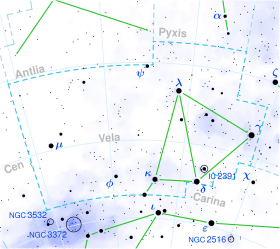GX Velorum
 | |
| Observation data Epoch J2000.0 Equinox J2000.0 | |
|---|---|
| Constellation | Vela |
| Right ascension | 09h 11m 04.39802s[1] |
| Declination | −44° 52′ 04.4411″[1] |
| Apparent magnitude (V) | +4.99[2] (4.97 to 5.04)[3] |
| Characteristics | |
| Spectral type | B5 Ia[4] |
| U−B color index | −0.57[5] |
| B−V color index | +0.22[5] |
| Variable type | α Cyg?[3] |
| Astrometry | |
| Radial velocity (Rv) | +28.2±0.8[6] km/s |
| Proper motion (μ) | RA: −5.608[1] mas/yr Dec.: +3.843[1] mas/yr |
| Parallax (π) | 0.7696 ± 0.1585[1] mas |
| Distance | approx. 4,200 ly (approx. 1,300 pc) |
| Absolute magnitude (MV) | −7.20[7] |
| Details[8] | |
| Mass | 35 M☉ |
| Radius | 61±7[9] R☉ |
| Luminosity | 214,000[9] L☉ |
| Surface gravity (log g) | 2.12±0.05[9] cgs |
| Temperature | 15,000±150[9] K |
| Rotational velocity (v sin i) | 39 km/s |
| Age | 8.3[10] Myr |
| Other designations | |
| Database references | |
| SIMBAD | data |
GX Velorum is a solitary[12] variable star[3] in the southern constellation of Vela. It is visible to the naked eye as a faint, blue-white hued star with an apparent visual magnitude that fluctuates around 4.99.[2] Based upon parallax measurements, it is located approximately 4,200 light years distant from the Sun, and is drifting further away with a radial velocity of +28 km/s.[6] It may be a member of the Vela OB1 association of co-moving stars.[7]
This object is a massive blue supergiant with a stellar classification of B5 Ia.[4] It is suspected to be an Alpha Cygni-type pulsating variable and ranges in brightness from 4.97 down to 5.04 magnitude.[3] It is losing mass at the rate of (0.40±0.02)×10−6 M☉ yr−1,[9] or one solar mass every 2.5 million years. The star is 8.3[10] million years old with 35 times the mass of the Sun.[8] It has expanded to around 61[9] times the Sun's radius and is radiating 214,000[9] times the luminosity of the Sun from its enlarged photosphere at an effective temperature of 15,000 K.[9]
References[]
- ^ a b c d e Brown, A. G. A.; et al. (Gaia collaboration) (August 2018). "Gaia Data Release 2: Summary of the contents and survey properties". Astronomy & Astrophysics. 616. A1. arXiv:1804.09365. Bibcode:2018A&A...616A...1G. doi:10.1051/0004-6361/201833051. Gaia DR2 record for this source at VizieR.
- ^ a b Anderson, E.; Francis, Ch. (2012). "XHIP: An extended hipparcos compilation". Astronomy Letters. 38 (5): 331. arXiv:1108.4971. Bibcode:2012AstL...38..331A. doi:10.1134/S1063773712050015. S2CID 119257644.
- ^ a b c d Samus', N. N; et al. (2017). "General catalogue of variable stars: Version GCVS 5.1". Astronomy Reports. 61 (1): 80. Bibcode:2017ARep...61...80S. doi:10.1134/S1063772917010085. S2CID 125853869.
- ^ a b Houk, Nancy (1978). Michigan catalogue of two-dimensional spectral types for the HD stars. Vol. 2. Ann Arbor: Dept. of Astronomy, University of Michigan. Bibcode:1978mcts.book.....H.
- ^ a b Ducati, J. R. (2002). "VizieR Online Data Catalog: Catalogue of Stellar Photometry in Johnson's 11-color system". CDS/ADC Collection of Electronic Catalogues. 2237. Bibcode:2002yCat.2237....0D.
- ^ a b Gontcharov, G. A. (2006). "Pulkovo Compilation of Radial Velocities for 35 495 Hipparcos stars in a common system". Astronomy Letters. 32 (11): 759–771. arXiv:1606.08053. Bibcode:2006AstL...32..759G. doi:10.1134/S1063773706110065. S2CID 119231169.
- ^ a b Reed, B. Cameron (2000). "Vela OB1: Probable New Members and Hertzsprung-Russell Diagram". The Astronomical Journal. 119 (4): 1855–1859. Bibcode:2000AJ....119.1855R. doi:10.1086/301313.
- ^ a b Fraser, M.; et al. (2010). "Atmospheric parameters and rotational velocities for a sample of Galactic B-type supergiants". Monthly Notices of the Royal Astronomical Society. 404 (3): 1306. arXiv:1001.3337. Bibcode:2010MNRAS.404.1306F. doi:10.1111/j.1365-2966.2010.16392.x. S2CID 118674151.
- ^ a b c d e f g h Haucke, M.; et al. (June 2018), "Wind properties of variable B supergiants. Evidence of pulsations connected with mass-loss episodes", Astronomy & Astrophysics, 614: 28, arXiv:1902.01341, Bibcode:2018A&A...614A..91H, doi:10.1051/0004-6361/201731678, A91
- ^ a b Tetzlaff, N.; et al. (2011). "A catalogue of young runaway Hipparcos stars within 3 kpc from the Sun". Monthly Notices of the Royal Astronomical Society. 410 (1): 190–200. arXiv:1007.4883. Bibcode:2011MNRAS.410..190T. doi:10.1111/j.1365-2966.2010.17434.x. S2CID 118629873.
- ^ "GX Vel". SIMBAD. Centre de données astronomiques de Strasbourg. Retrieved 2019-08-16.
- ^ Eggleton, P. P.; Tokovinin, A. A. (September 2008). "A catalogue of multiplicity among bright stellar systems". Monthly Notices of the Royal Astronomical Society. 389 (2): 869–879. arXiv:0806.2878. Bibcode:2008MNRAS.389..869E. doi:10.1111/j.1365-2966.2008.13596.x. S2CID 14878976.
- B-type supergiants
- Alpha Cygni variables
- Vela (constellation)
- Durchmusterung objects
- Henry Draper Catalogue objects
- Hipparcos objects
- HR objects
- Objects with variable star designations